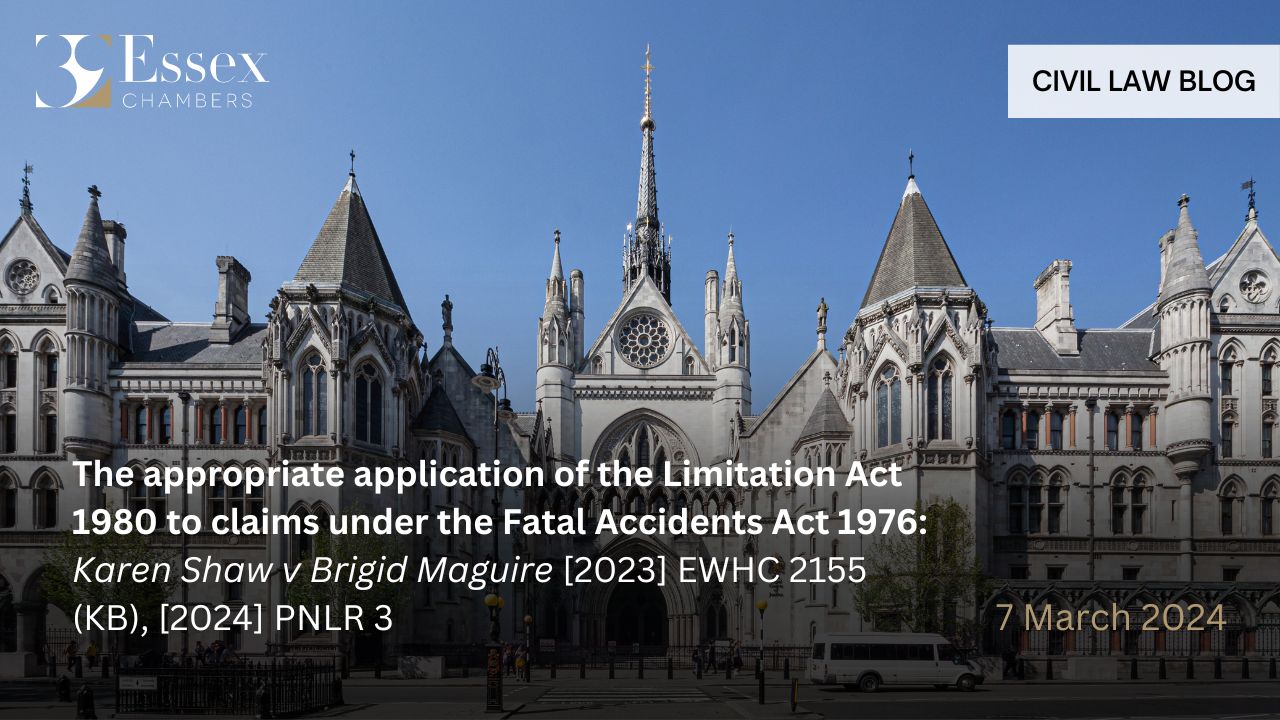The appropriate application of the Limitation Act 1980 to claims under the Fatal Accidents Act 1976: Karen Shaw v Brigid Maguire [2023] EWHC 2155 (KB), [2024] PNLR 3

Can a dependant bringing a claim pursuant to the Fatal Accidents Act 1976 (‘FAA 1976’) ask the Court to extend the limitation period under section 33 of the Limitation Act 1980 (‘LA 1980’) even when the deceased’s death occurred more than three years before issuing a claim? This preliminary issue came before Master Cook in the recent clinical negligence claim of Karen Shaw v Brigid Maguire.
The relevant legislation is as follows:
12 Special time limit for actions under Fatal Accidents legislation.
(1)An action under the Fatal Accidents Act 1976 shall not be brought if the death occurred when the person injured could no longer maintain an action and recover damages in respect of the injury (whether because of a time limit in this Act or in any other Act, or for any other reason).
Where any such action by the injured person would have been barred by the time limit in section of this Act, no account shall be taken of the possibility of that time limit being overridden under section 33 of this Act.
(2)None of the time limits given in the preceding provisions of this Act shall apply to an action under the Fatal Accidents Act 1976, but no such action shall be brought after the expiration of three years from—
(a)the date of death; or
(b)the date of knowledge of the person for whose benefit the action is brought; whichever is the later.
33 Discretionary exclusion of time limit for actions in respect of personal injuries or death.
(1)If it appears to the court that it would be equitable to allow an action to proceed having regard to the degree to which—
(a)the provisions of section 11 or 12 of this Act prejudice the plaintiff or any person whom he represents; and
(b)any decision of the court under this subsection would prejudice the defendant or any person whom he represents;
the court may direct that those provisions shall not apply to the action, or shall not apply to any specified cause of action to which the action relates.
The court shall not under this section disapply section 12(1) except where the reason why the person injured could no longer maintain an action was because of the time limit in section 11…”
Two leading practitioner texts took different approaches to the issue: the authors of Kemp & Kemp suggested the Court had no power to resurrect a right of action which had already expired by the time of the deceased’s death, referring to the express statement in s.12(1) that no account should be taken of the possibility of a time limit being overridden under s.33: see paragraph 29-011. The authors noted, however, the confusion caused by s.13 of LA 1980 which appears to make s.12(1) void by granting back a right to take into account the deceased’s ability to make a s.33 application. Reference was made to the Court of Appeal decision of Young v Western Power Distribution plc [2003] EWCA Civ 1034 where the court held the claim was limitation-barred and there was no discretion allowed under s.33. However that decision rested on the now-overturned case of Walkley v Precision Forgings [1979] 1 WLR 606 so confusion reigned as to how a court would deal with this issue gripped anew.
The authors of Clerk and Lindsell on Torts, 24th ed., had a firm view and wrote at §30-70: “Although the possibility that the deceased could have invoked the court’s s.33 discretion is disregarded when determining whether his cause of action was statute-barred, the claimants in a Fatal Accidents Act claim may ask the court to exercise its discretion under s.33 of the Limitation Act 1980 and override the limitation period which would have barred the deceased’s claim, and hence bars theirs. This is provided for by s.33. The power of the court in this respect is qualified, however, by s.33(2). It can only ‘disapply’ for these purposes the normal time-limit in personal injury cases. If the deceased’s claim was statute-barred by, say, the time-limit in the Carriage by Air Act 1961, there is no power to override.”
Master Cook preferred the Clerk and Lindsell approach: in his view the effect of s.12(1) taken together with s.33(2) is that where an injured person with capacity dies three years or more after the accident or date of knowledge without commencing proceedings, the only avenue open to the personal representative on behalf of the dependants is to commence proceedings and apply to the court to exercise its discretion under s.33 to disapply the limitation period.
Master Cook found the date of knowledge was June 2013, over 5½ years before the extant proceedings were issued, but exercised his discretion to extend the limitation period on the facts of this case finding there were good reasons for the delay. In particular he found that the Claimant’s former solicitors had failed to serve the claim form in time.
In summary therefore, a substantial delay in issuing a FAA claim need not be fatal. A dependant bringing a FAA claim after the end of the limitation period will still need to persuade the Court to exercise the balancing act under s.33 in their favour. However in cases of clinical negligence where the date of knowledge is often acquired many years after the negligent event the decision in Shaw v Maguire will doubtless provide encouragement to claimants who have been delayed through no fault of their own.
Image credit to David Castor

